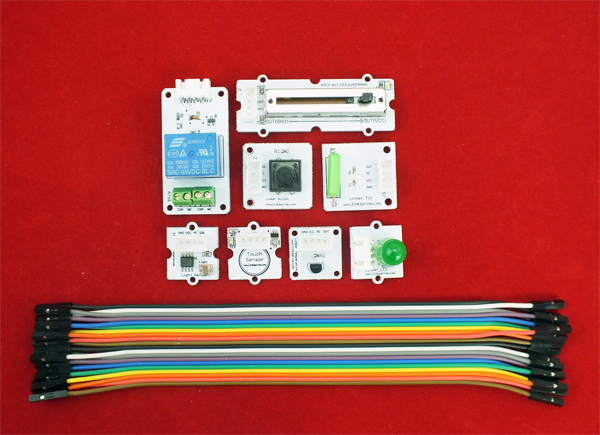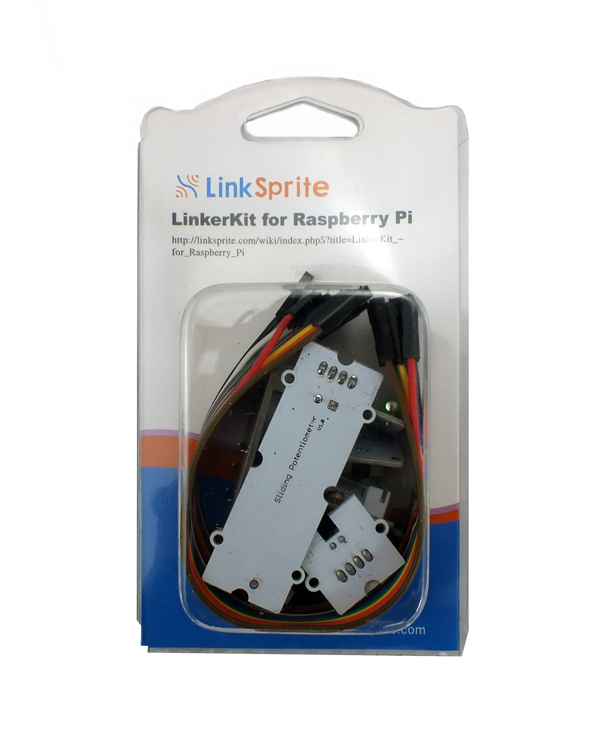Difference between revisions of "LinkerKit for Raspberry Pi"
(→Linker Light Sensor) |
(→Tutorial) |
||
| Line 172: | Line 172: | ||
GPIO.output(relay_pin,False) | GPIO.output(relay_pin,False) | ||
time.sleep(0.5) | time.sleep(0.5) | ||
| + | |||
| + | </syntaxhighlight> | ||
| + | |||
| + | |||
| + | ===Linker Slide Potentiometer=== | ||
| + | |||
| + | To use this module with RPI, we need a [http://linksprite.com/wiki/index.php5?title=Linker_kit_Base_Shield_for_Raspberry_Pi_with_ADC_Interface shield ]. | ||
| + | |||
| + | If you don't have this shield, you can follow the instructions at [http://scruss.com/blog/2013/02/02/simple-adc-with-the-raspberry-pi/ here]. | ||
| + | |||
| + | Python code: | ||
| + | |||
| + | <syntaxhighlight lang="c"> | ||
| + | import spidev | ||
| + | import time | ||
| + | |||
| + | # A0 = 0, A1 = 1, A2 = 2, A3 =3 | ||
| + | temp_channel = 1 | ||
| + | print ("Please the linker_temperature is connected to A%1d\n" % temp_channel) | ||
| + | |||
| + | spi = spidev.SpiDev() | ||
| + | spi.open(0,0) | ||
| + | |||
| + | def readadc(adcnum): | ||
| + | # read SPI data from MCP3004 chip, 4 possible adc's (0 thru 3) | ||
| + | if adcnum > 3 or adcnum < 0: | ||
| + | return -1 | ||
| + | r = spi.xfer2([1,8+adcnum <<4,0]) | ||
| + | adcout = ((r[1] &3) <<8)+r[2] | ||
| + | return adcout | ||
| + | |||
| + | while True: | ||
| + | value = readadc(temp_channel) | ||
| + | volts = (value * 3.3) / 1024 | ||
| + | |||
| + | print("value = %4d/1023" % value) | ||
| + | print("volts = %5.3f V" % volts ) | ||
| + | print"------------------" | ||
| + | time.sleep(0.5) | ||
| + | |||
</syntaxhighlight> | </syntaxhighlight> | ||
Revision as of 15:52, 31 July 2013
This pack includes the following components:
- Button Module [LINKER_BUTTON][118101002]
- 5mm Green LED Module [LINKER_5MMGREEN][118101001]
- LDR Module [LINKER_LDR][118101003]
- Thermal Module [LINKER_TEMP][118101005]
- Linear/Slide Potentiometer Module [LINKER_LINEPOTENT][118101006]
- Tilt Module [LINKER_TLT][118101004]
- Touch Sensor Module [LINKER_TOUSEN][118101007]
- Relay Module [LINKER_RELAY][118101008]
- Female to female jumper wires
Contents
Tutorial
In this tutorial, we are going to explain how to use Python to do the experiments:
Environment Setup
Now we will install python-pip (pip is a package used to install and manage python software package, and it is used replace esay_install):
sudo apt-get install python-imaging python-imaging-tk python-pip python-dev git
Next, we will install spidev using pip:
sudo pip install spidev
Then we will install WiringPi (the driver for IOs on Raspberry pi, that can be used in C, shell script or Python, etc):
sudo pip install wiringpi
Linker Button
Connect linker_led to pin 27 of RPI, connect linker_button to pin 23 of RPI
Python code:
<syntaxhighlight lang="c">
import RPi.GPIO as GPIO
led_pin = 27 button_pin = 23
GPIO.setmode( GPIO.BCM ) GPIO.setup( led_pin,GPIO.OUT ) GPIO.setup( button_pin, GPIO.IN, pull_up_down=GPIO.PUD_UP)
print ("\nlinker_led pin 27 , linker_button pin 23\n")
while True: if GPIO.input(button_pin): GPIO.output(led_pin,True) else : GPIO.output(led_pin,False) </syntaxhighlight>
Linker LED
Connect linker led to pin 27 of RPI.
Python code:
<syntaxhighlight lang="c">
import RPi.GPIO as GPIO import time
led_pin = 27
GPIO.setmode(GPIO.BCM) GPIO.setup(led_pin,GPIO.OUT)
print "\nlinker led pin 27\n"
while True:
GPIO.output(led_pin,True) time.sleep(0.5) GPIO.output(led_pin,False) time.sleep(0.5) </syntaxhighlight>
Linker Light Sensor
To use this module with RPI, we need a shield .
If you don't have this shield, you can follow the instructions at here.
Python code:
<syntaxhighlight lang="c">
import RPi.GPIO as GPIO import spidev import time
led_pin = 27
- A0 = 0, A1 = 1, A2 = 2, A3 =3
temp_channel = 0
GPIO.setmode( GPIO.BCM ) GPIO.setup( led_pin,GPIO.OUT ) spi = spidev.SpiDev() spi.open(0,0)
print "\nlinker led pin 27" print ("Please the linker_temperature is connected to A%1d\n" % temp_channel) time.sleep(3)
def readadc(adcnum):
- read SPI data from MCP3004 chip, 4 possible adc's (0 thru 3)
if adcnum > 3 or adcnum < 0:
return -1
r = spi.xfer2([1,8+adcnum <<4,0])
adcout = ((r[1] &3) <<8) + r[2]
return adcout
while True: value = readadc(temp_channel) volts = (value * 3.3) / 1024 print("value = %4d/1023" % value) print("volts = %5.3f V\n" % volts ) if value > 10 : GPIO.output(led_pin,True) else : GPIO.output(led_pin,False) time.sleep(0.5)
</syntaxhighlight>
Linker Relay
To use this module with RPI, we need a shield .
If you don't have this shield, you can follow the instructions at here.
Python code:
<syntaxhighlight lang="c"> import RPi.GPIO as GPIO import time
relay_pin = 23
GPIO.setmode( GPIO.BCM ) GPIO.setup( relay_pin,GPIO.OUT )
print "\nlinker relay pin 23\n"
while True:
GPIO.output(relay_pin,True) time.sleep(0.5) GPIO.output(relay_pin,False) time.sleep(0.5)
</syntaxhighlight>
Linker Slide Potentiometer
To use this module with RPI, we need a shield .
If you don't have this shield, you can follow the instructions at here.
Python code:
<syntaxhighlight lang="c"> import spidev import time
- A0 = 0, A1 = 1, A2 = 2, A3 =3
temp_channel = 1 print ("Please the linker_temperature is connected to A%1d\n" % temp_channel)
spi = spidev.SpiDev() spi.open(0,0)
def readadc(adcnum):
- read SPI data from MCP3004 chip, 4 possible adc's (0 thru 3)
if adcnum > 3 or adcnum < 0:
return -1
r = spi.xfer2([1,8+adcnum <<4,0])
adcout = ((r[1] &3) <<8)+r[2]
return adcout
while True: value = readadc(temp_channel) volts = (value * 3.3) / 1024
print("value = %4d/1023" % value) print("volts = %5.3f V" % volts ) print"------------------" time.sleep(0.5)
</syntaxhighlight>

